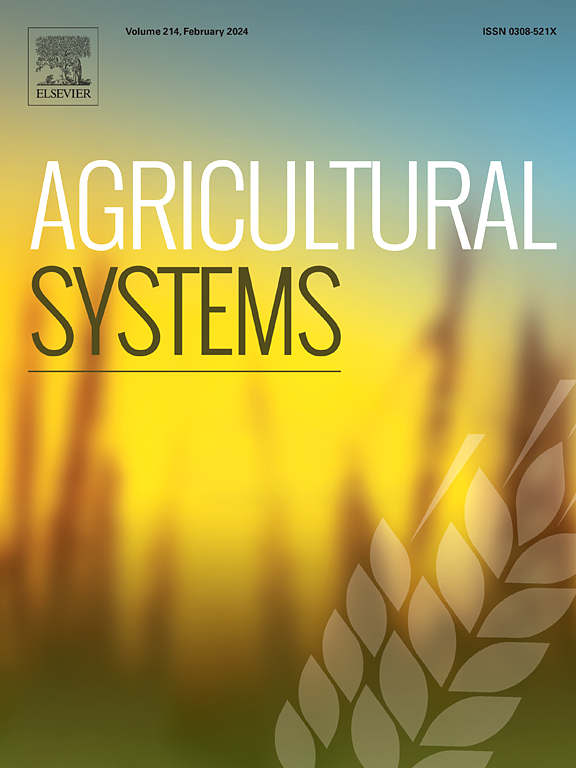风险承受能力和气候问题预示着农业用地的转型变化
IF 6.1
1区 农林科学
Q1 AGRICULTURE, MULTIDISCIPLINARY
引用次数: 0
摘要
内容研究和政策不断强调转型适应(涉及全新的系统、流程或活动地点)对于气候和其他未来变化(包括农业)的潜在重要性。尽管如此,在行动中实施变革性变化的实例却很少,人们对促成或促进变革性变化的驱动因素也缺乏足够的了解。目标我们评估了过去十年中农民在其农场实施变革性或渐进性土地利用变化的程度,以及他们在未来实施这两类变化的可能性,并特别强调了受访者的耐心(即低贴现率)和风险。我们利用对新西兰各地的农民、林农和种植者进行的大规模互联网调查数据。参与者是通过行业机构和政府数据库招募的,最终样本包括 4458 名受访者,代表了新西兰第一产业的所有主要活动和全国所有 65 个地区。结果与结论 我们发现,转变土地利用方式确实很少见--只有 15% 的农民在过去实施了转变土地利用方式的措施,只有 11% 的农民打算在未来实施这种措施。此外,转型性土地利用变化在某些行业比其他行业更常见,其中耕地行业的转型性变化程度最高;相比之下,渐进性变化在所有行业都很常见。令人惊讶的是,个人的耐心一般与实际或打算进行的调整无关,但风险容忍度却是预测变化的一个重要因素。意义鉴于变革性变化涉及高风险,而且往往代价高昂,这些结果突出表明了社会投资的重要性,以在需要时促进变革性变化,因为许多人--尤其是边缘化或资源不足的生产者--实施变革的能力微乎其微。这项工作确定了哪些行业和生产者的特点可能最需要投资来实施转型变革,以应对一系列快速变化的农业条件。本文章由计算机程序翻译,如有差异,请以英文原文为准。

Risk tolerance and climate concerns predict transformative agricultural land use change
CONTEXT
Research and policy continue to highlight the potential importance of transformative adaptations (involving wholly new systems, processes, or locations for activities) for climate and other future changes, including in agriculture. Despite this, there are few examples of transformative changes in action and insufficient understanding about the drivers that enable or facilitate transformative change.
OBJECTIVE
We assess the extent to which farmers have implemented transformative or incremental land use changes on their farms over the previous ten years and their likelihood to implement both types of changes in the future, with a particular emphasis on respondents' patience (i.e. low discount rates) and risk preferences, which we expect to have differing effects on change type.
METHODS
We utilize data from a large-scale, Internet-based survey of farmers, foresters, and growers from across New Zealand. Participants were recruited through industry bodies and government databases, and the final sample includes 4458 respondents representing all major activities in New Zealand's primary sector and all 65 districts in the country. The sample is broadly representative by both demographics and industry.
RESULTS AND CONCLUSION
We find that transformative land use changes are indeed rare - only 15 % of farmers had implemented transformative land use changes in the past, and only 11 % intended to implement them in the future. Furthermore, transformative land use changes are more common in some industries than others, with the arable sector having the highest levels of transformative change; in contrast, incremental change is common across all sectors. Surprisingly, individual patience was not generally associated with actual or intended adaptations, but risk tolerance was a strong predictor of change. Furthermore, risk-tolerant individuals who also expressed climate change belief were significantly more likely to have already implemented transformative change.
SIGNIFICANCE
Given that transformative changes involve high risk and are often costly, these results highlight the importance of societal investment to foster transformative changes where needed, as many individuals – especially marginalized or under resourced producers – will have minimal capacity for their implementation. This work identifies the industries and characteristics of producers that may need the greatest investment to implement transformative changes to respond to a host of rapidly changing agricultural conditions.
求助全文
通过发布文献求助,成功后即可免费获取论文全文。
去求助
来源期刊

Agricultural Systems
农林科学-农业综合
CiteScore
13.30
自引率
7.60%
发文量
174
审稿时长
30 days
期刊介绍:
Agricultural Systems is an international journal that deals with interactions - among the components of agricultural systems, among hierarchical levels of agricultural systems, between agricultural and other land use systems, and between agricultural systems and their natural, social and economic environments.
The scope includes the development and application of systems analysis methodologies in the following areas:
Systems approaches in the sustainable intensification of agriculture; pathways for sustainable intensification; crop-livestock integration; farm-level resource allocation; quantification of benefits and trade-offs at farm to landscape levels; integrative, participatory and dynamic modelling approaches for qualitative and quantitative assessments of agricultural systems and decision making;
The interactions between agricultural and non-agricultural landscapes; the multiple services of agricultural systems; food security and the environment;
Global change and adaptation science; transformational adaptations as driven by changes in climate, policy, values and attitudes influencing the design of farming systems;
Development and application of farming systems design tools and methods for impact, scenario and case study analysis; managing the complexities of dynamic agricultural systems; innovation systems and multi stakeholder arrangements that support or promote change and (or) inform policy decisions.
 求助内容:
求助内容: 应助结果提醒方式:
应助结果提醒方式:


